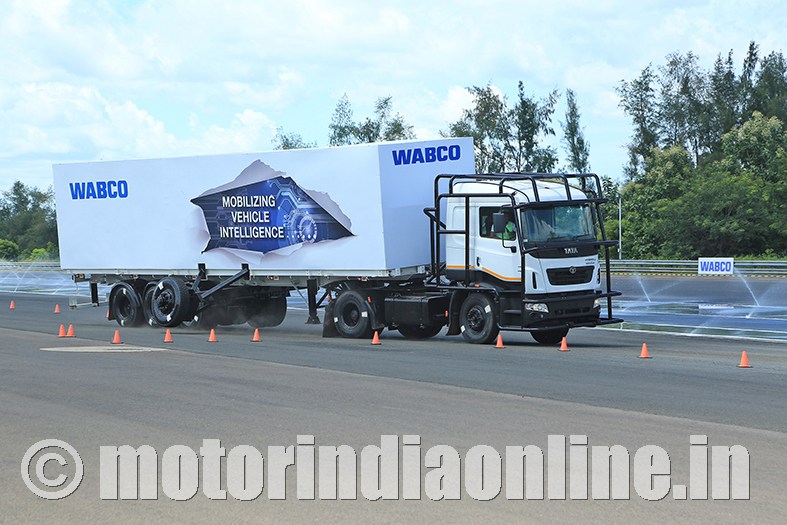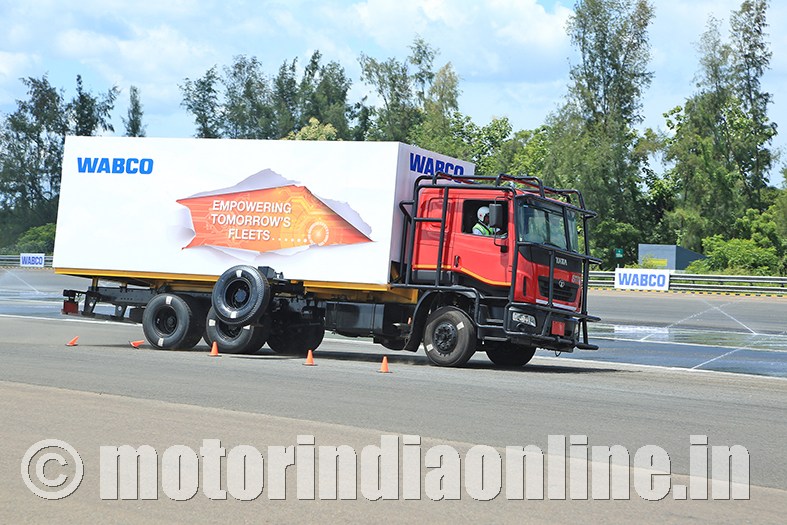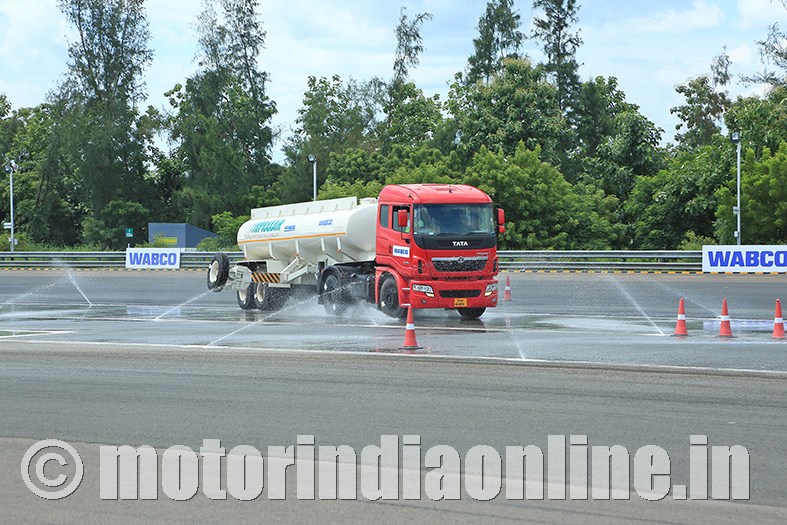The majestic white truck was picking up speed on the dry tarmac and approaching the spectator stand beside the track in a hurry. As the separation distance rapidly diminished spectators could discern that the vehicle advancing in their direction was indeed a HCV, 40 ton tractor-trailer with load body. At a good speed and just in front of them, the vehicle took a sharp turn away from the stand as if avoiding some collision, and soon straightened back to continue in the linear path. The tractor responded admirably to the driver’s manoeuvre but the trailer behind, after negotiating the swerve and following the tractor, had its wheels facing the spectators off from the ground in a jiffy, load body precariously tilting and set for a roll-over. Thankfully that did not happen.
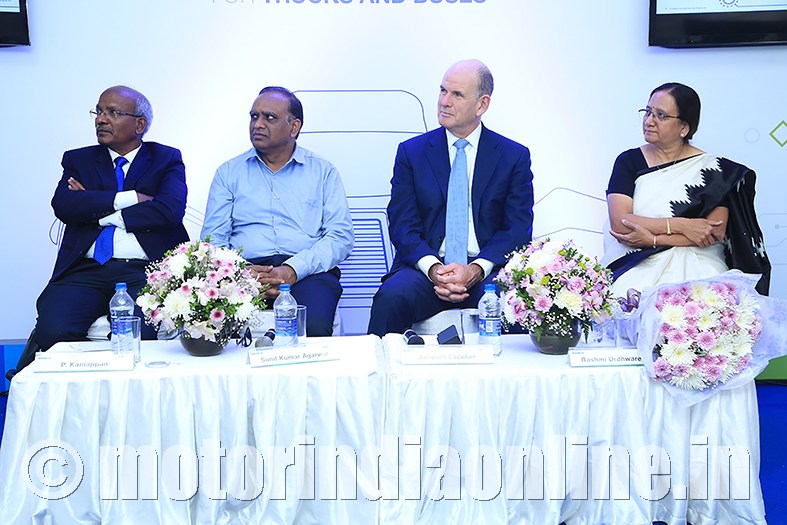
Soon the trailer wheels thudded back on to tarmac to obediently follow the tractor and then the high decibel ‘wow’ reaction and applause broke out from the spectators watching the event. What appeared to be an orchestrated stunt action by an expert at the wheel was indeed a controlled rolling manoeuvre demo on the WABCO test track in Chennai by one of the experienced and skilled drivers, and thanks to the outrigger wheel assembly fixed on the trailer chassis, the vehicle did not roll over.
In real life situations necessitating such reflex emergency manoeuvres, how do you prevent roll-overs in the absence of outriggers?
The answer for the same was provided by WABCO in the next test run of the same truck with identical operating parameters and manoeuvre excepting that the truck‘s Electronic Stability Control (ESC) was switched on. The speed was automatically reduced thro’ ESC-enabled braking systems and the vehicle, after swerving and straightening back, did not roll and all the wheels were firmly gripping the tarmac all thro’ the run.
The spectators gave the demo once again a thundering applause. Well, WABCO could sense from the spontaneous appreciation and vetting of the ESC that they have a winner on their hand. The ESC technology showcased for the first time in India for trucks and buses had unambiguously bugled the arrival of the next level safety for the Indian transport sector.
The commercial launch was at WABCO India’s proving ground in Chennai on October 4. The test track demos were preceded by introduction of the technology and on-stage inauguration of the gradient hill. Government officials, fleet operators, OEMs, media, etc., were present at the product presentations and launch. WABCO’s hosts for the occasion were Mr. Jacques Esculier, Chairman and Chief Executive Officer, WABCO, Mr. P. Kaniappan, Managing Director, WABCO India, and Mr. Dirk Wohltmann, Director – Engineering, WABCO India, and the special guests for the occasion included Mrs. Rashmi Urdhwareshe, Director, Automotive Research Association of India, and Mr. Sunil Agarwal, Senior General Manager, Engineering & Research Centre, Tata Motors.
ESC for a safer future
Welcoming the guests, Mr. Kaniappan said that WABCO was proud to be associated with Tata Motors in the launch of ESCsmart firstly as a customer and secondly as being the leader in the CV segment for safety technology.
Mr. Esculier, talking about the journey towards a safer future, indicated WABCO’s global leadership in innovating technologies that contribute to safer and more efficient road transportation of people and goods. He added that following the pioneering introduction of ABS for the CV sector, they were proud to launch the ESCsmart and to play a key role in further supporting the Government vision to reduce accidents.
Mr. Kaniappan, in his address, focussed on issues concerning local market, viz., WABCO’s commitment to safety, accident scenario and association with Tata Motors in bringing ESCsmart to India. He added that during 1999 WABCO (erstwhile Sundaram Clayton) had the vision to invest on a test track even before the Government move in that direction. Additional investments have been done on test hill for AMT and other safety features to convert it into a centre of excellence in India.
He also highlighted the dismal accidents scenario in India, about one-third being caused by CV and over 80% of CV accidents taking place due to driver losing control. An ESC incorporation is likely to drastically reduce accidents thro’ autonomously-controlled braking in emergency manoeuvres.
Forward-looking initiative
ESC comes into play in certain circumstances where critical vehicle manoeuvres or driving situations are encountered, said Mr. Wohltmann while explaining the features and role of the ESC system. He added: “ESC supports the driver in such situations to limit the impact or prevent accidents. ESC autonomously takes over the control to apply brakes, interact with engine to reduce the speed and bring the vehicle back to the path intended by the driver. The loss of control due to skidding resulting from poor tyre road conditions or wet slippery road is prevented by the yaw control. The rollover of the vehicle especially around the curve in dry road conditions is prevented by the roll stability control.”
Mr. Agarwal who addressed the gathering talked about the commitment to safety of Tata Motors and highlighted various features, both mandated and otherwise, in their vehicles. Mrs. Rashmi Urdhwareshe appreciated the proactive work of WABCO and Tata in raising the safety bar and later remotely inaugurated the gradient hill of WABCO.
Following the same, WABCO demonstrated the ABS and ESC features on the test track. The demos included tests with rigid truck and tractor-trailer; on surfaces that included dry asphalt, split surface (wet/dry asphalt & wet basalt); with and without ABS, ESC and vehicle roll under different conditions.
The time for ESC adoption has certainly arrived, especially after the introduction electronic engine, and we could witness the adoption in a big way even before it is mandated; and the imminent paradigm shift likely to take the safety aspects to a higher orbit.
“Braking is the backbone of autonomous driving as the same controls the energy and stability of the vehicles. Steering capability has been recently added to our portfolio, and we are the first company globally to offer full braking and steering for control,” said Mr. Esculier, commenting on the future path in the segment.
Excerpts of the absorbing interactions of Mr. Esculier and Mr. Kaniappan with media follow:
Please tell us about the penetration of ESC in the global markets and the same eventually getting mandated, and its adoption for rigid and tractor-trailer versions.
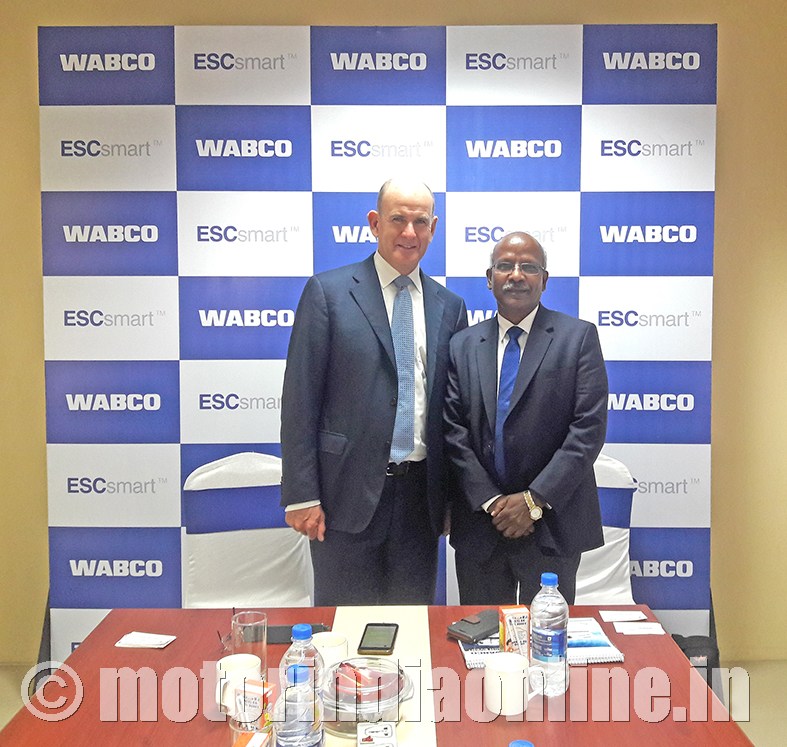
Mr. Esculier: ESC was mandated in Europe long ago and the process is on in the US too. Many countries are looking to mandate it, including India. Once you have the ABS, this is the next logical step. Even before mandating it, we want to take technology to the customers to prove its utility for applications. There will be push back if this is not done before mandating it. Efficiency of the assets utilisation is the best in the tractor-trailer combination for the long haul. With one tractor, multiple trailer units can be serviced. With GST getting implemented, there are no issues in crossing borders. Also, considering the higher hp and speeds and more freeways, I see the tractor-trailer as the way forward in long haul and, with ESC’s significant safety benefits, see its early adoption for this application.
Can you comment on the focus customer segments and the acceptance of ESC in a price sensitive and competitive local market?
Mr. Kaniappan: More than the costs, it’s the value what the customer sees in the product that will set the trend. With E-commerce taking off in a big way, I see the requirement of ESC herein for safety needs. What used to take 7 days earlier from Chennai to Jamshedpur by trucking, is being covered in 2 days by certain fleet operators thro’ their 24X7 driver-relay teams and their endeavour to meet air cargo delivery times.
Increase in speeds and the importance of accident-free operations hence have become an important consideration for the application. Also in hazardous goods movement, intercity buses and long haul in hub section of logistics there is a big value to have ESC. We are looking at cost issues to offer an affordable unit and, with ABS already available, this will be an add-on unit with only an incremental cost addition as many of the ABS elements and subassemblies will be utilised for ESC operations.
Considering the increasing tech disruptions, confirm if detection, data processing and corrective actuation will all come within the ambit of WABCO down the timeline.
Mr. Esculier: There is the blue print to progressively bring the technology from past to autonomous vehicle but it will take some time. The three pillars of growth, viz., detection, processing and actuation, are around this blue print. Detection is done by the sensors, but we don’t manufacture it as the volumes are not adequate. We source it from reputed suppliers around the globe. As regards processing of data there are two different routes, viz., short-term reactive reaction and developing a strategy for the truck and the latter involves development of artificial intelligence (AI) capability. The third is in the execution or actuation which is WABCO’s forte. At some stage all will come under WABCO’s purview but AI for truck strategy will arrive when we see graduation to higher levels of technology in the CV domain.
Brief us on your India approach, ESC localisation and production capacity to address the market demands for various products, including AMT, ABS and ESC.
Mr. Esculier: WABCO wants to be present in the new technology areas and foresee the centre of gravity of the operations moving to India. It will be blending the design & software skills and frugal approach of the Indian centre with the proven technology of WABCO that will set the trend.
Mr. Kaniappan: As regards localisation, electronics will be with imports till sufficient volume is reached. We are looking at mechanical parts for localisation, and not many additional lines will be needed to produce the same. AMT, of course, is 100% localised. With the advent of the electronic engine, it’s just about the right time to focus on ESC, and talks are on with the Government for it getting mandated. We have the necessary production capacity and capabilities to meet the demands for the products in our program and that in the pipeline.
Indicate the future plans of WABCO and the aligning product program to meet the scenarios ranging from electric trucks to autonomous driving.
Mr. Esculier: Big vehicle manufacturers have their own resources to address the autonomous driving, but many will need WABCO to help them out in this area, and we see big opportunities. Apart from our main truck focus, off highway equipment and military sectors offer a good opportunities for growth. With the acquisition of a hydraulics company, we can now offer a full range of solutions covering pneumatics and hydraulics.
The next step will be to connect steering with brakes, and this will be a big step forward. We have demonstrated that by differential braking we can control the directions without a steering though it wears out the brakes fast. The important thing however is that in the event of a steering failure, we can safely steer the truck and bring it under control.
